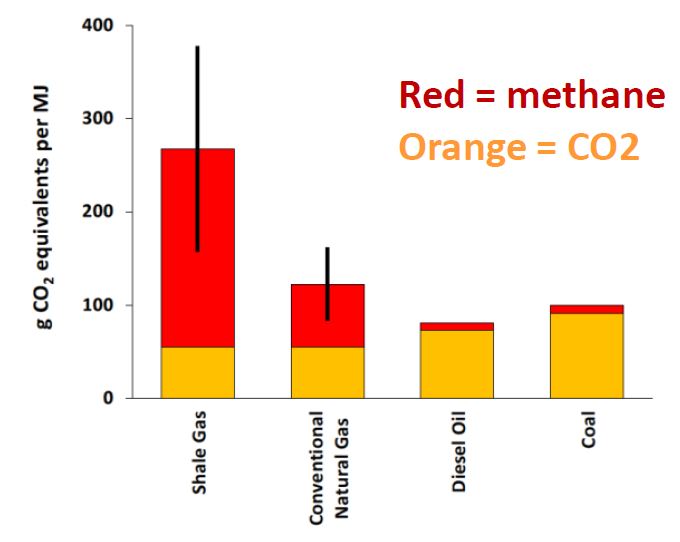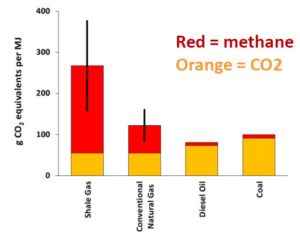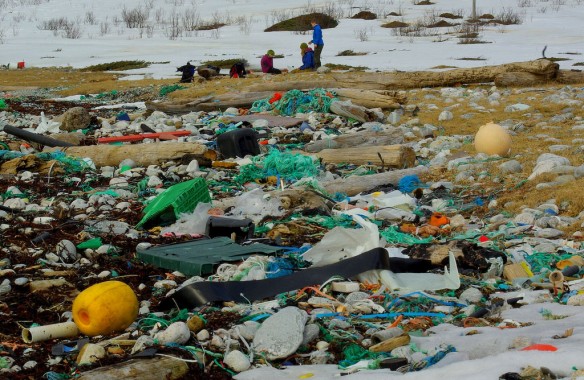Robert W. Howarth, 26.10.2016
Natural gas is widely (and falsely) promoted as a bridge fuel that allows continued use of fossil fuels while reducing greenhouse gas emissions compared to oil or coal. Indeed, less carbon dioxide is emitted when burning natural gas, but natural gas is composed mostly of methane. Emissions of even small amounts of unburned methane give natural gas a huge greenhouse gas footprint since methane is more than 100 times more powerful as a greenhouse gas than carbon dioxide. Natural gas and coal are both climate disasters, with coal worse for carbon dioxide emissions but natural gas far worse from the standpoint of methane.
Scientific knowledge of methane emissions has progressed rapidly over the past 6 years, driven in part by the precipitous rise of shale gas development. For conventional natural gas, slightly less than 4% of the lifetime production of gas wells is emitted to the atmosphere, including both leaking and venting at the well site and during storage & delivery to consumers. For shale gas, information is more uncertain, but emissions are likely 3-fold greater, or 12% of lifetime production. Satellite data show a global increase in methane in the atmosphere since 2008, driven largely by shale gas and shale oil development in the United States. Commercial development of shale gas has not yet occurred outside of North America.
In December 2015 at the United Nations COP21 in Paris, the nations of the world agreed to keep the planet well below 2°C above the pre-industrial baseline, to reduce the risk of runaway global warming. Reducing methane is absolutely key to meeting this target: Earth’s climate system responds too slowly to reductions in carbon dioxide emissions, and warming to 2°C and higher will occur within the next 35 years unless methane emissions are reduced below current levels.
Within the next 12 to 15 years, the Earth will warm to very dangerous levels, doubling the total increase in the average temperature that has occurred since the start of the industrial revolution to now. Tipping points in the climate system may kick in and lead to runaway global warming. Only by reducing methane emissions and emissions of soot (black carbon, or BC) can society slow the rate of warming in this critical short-term timeframe, and buy precious time. The oil & gas industry is the single largest source of methane pollution, contributing one third of all methane pollution globally, and is by far the largest factor behind recent global increases in atmospheric methane.
When methane emissions are included, both conventional natural gas and shale gas have a larger greenhouse gas footprint than coal or oil.
Carbon dioxide vs. methane:
Methane is greater than 100 times more powerful as an agent of global warming than is carbon dioxide, while both gases are in the atmosphere.
The immediate influence of methane lasts for only the 12 years it remains in the atmosphere, while carbon dioxide affects the climate for hundreds of years after emission.
However, the climate responds slowly to changes in carbon dioxide emissions; reductions now will not influence the rate of warming over the coming 35 years.
The climate system responds very quickly to changes in methane emissions; reducing methane emissions now will significantly slow the rate of global warming over the coming decades.
Some commonly asked questions:
Aren’t carbon dioxide emissions less for natural gas than for coal?
Yes, substantially so. But methane emissions are far greater from natural gas, particularly from shale gas. When methane is included, total greenhouse gas emissions are greater from natural gas than from coal, particularly when analyzed on a 20-year period following emission.
I’ve heard that methane is 21-times more powerful as a greenhouse gas than is carbon dioxide. Is that true?
No, that is based on a 20-year old report of the Intergovernmental Panel on Climate Change (IPCC) in 1995. In 2013, the IPCC stated that methane is more than 100-times more powerful for the first decade after emission, 86-times over a 20-year period, and 34-times over 100 years. The shorter time periods are the most appropriate to use, given the urgency of slowing global warming over the coming 10 to 20 years.
Why are emissions so great from shale gas, and are shale gas emissions high in Europe as well as the US?
The shale gas revolution in the US began only in the past decade, mostly since 2009. As a result, scientific study of emissions is new and as such estimates are somewhat uncertain. But increasingly, many studies show methane emissions that are far greater than from conventional natural gas. One reason is release during drilling in older gas & oil fields and coal mines that often overlay the deeper shale gas reserves. To date, there has been virtually no shale gas development in Europe or anywhere outside North America.
Don’t some studies show low methane emissions?
The past 5 years have seen an explosion of new studies on methane emissions, with a wide range of results. Studies with some of the lowest emissions estimates are probably flawed, though, because of misuse of measurement equipment. Longer term, larger scale observations from monitoring networks and satellites provide the most robust estimates and indicate high emissions.
Can regulation reduce methane emissions to an acceptable level?
Methane emissions come from many sources, from the well site to delivery through pipelines to final customers. Many of these remain poorly characterized. Reducing emissions is expensive, and enforcement of regulations is difficult. Society is better off moving away from natural gas, and particularly shale gas.
If natural gas is not a bridge fuel, should we burn coal instead?
No. It is past time to move away from all fossil fuels, and embrace the renewable energy technologies of the 21st Century.
Aren’t cows more important as a source of methane than the natural gas industry?
Both animal agriculture and the oil & gas industry are big emitters, but the most recent research indicates fossil fuel sources are larger, and that recent increases in global methane are driven by fossil fuels, particularly natural gas.
This article appeared on the Cornell University website.
Further Reading:
Peer-Reviewed science: Howarth, 2015. “Perspectives on air emissions of methane and climatic warming risk from hydraulic fracturing and shale-gas development: Implications for policy.” Energy & Emission Control Technologies 3:45-54.
Popular press: McKibben, 2016. “Global warming’s terrifying new chemistry.” The Nation, April 11-18 issue.












